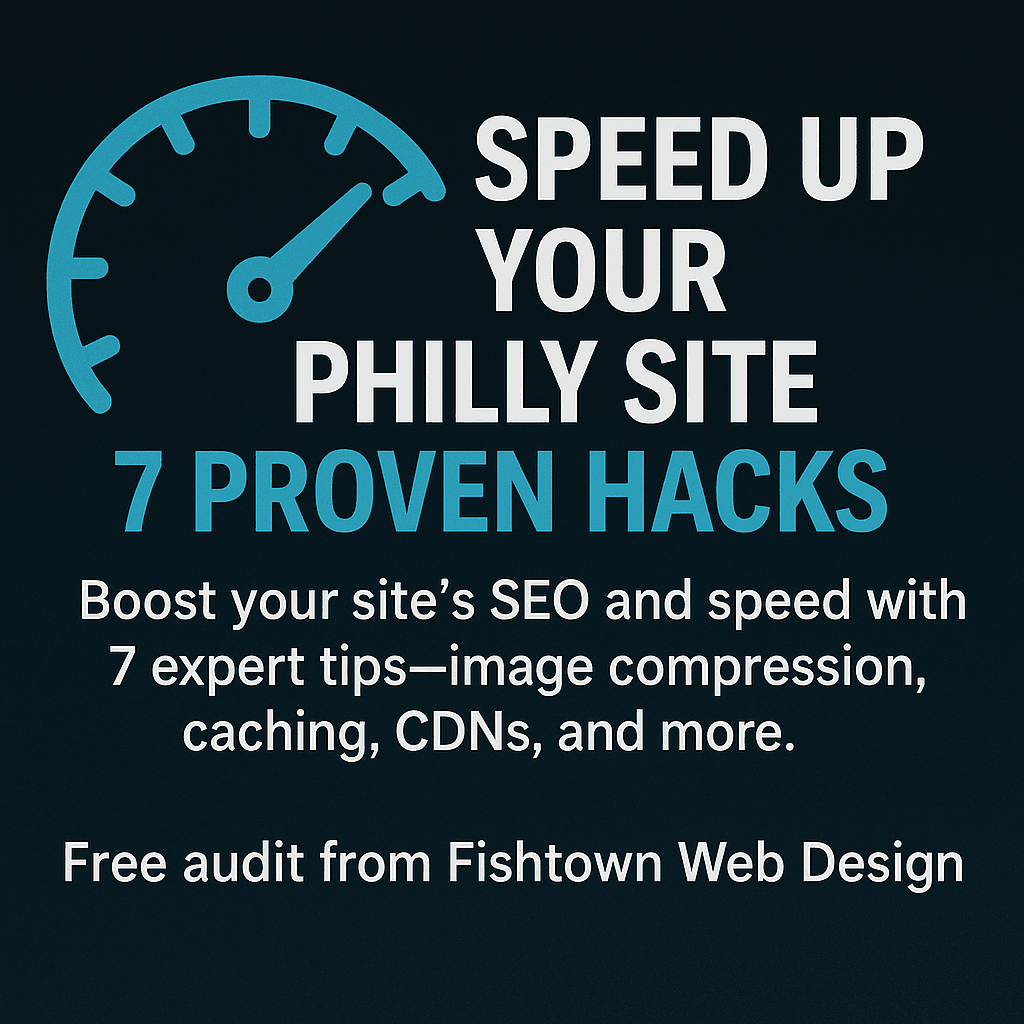7 Easy Website-Speed Hacks for Philadelphia Small Businesses

Published: May 22, 2025
If you run a small business in Philadelphia—whether you’re a Fishtown coffee shop, a South Philly pizzeria, or a Germantown boutique—your website’s load time can make or break a sale. A slow site frustrates visitors, drives up bounce rates, and hurts your Google rankings. These seven hands-on speed hacks will slash load times, improve Core Web Vitals, and give you an SEO edge in the Philly market.
1. Compress & Serve Next-Gen Image Formats
Why it matters: Images often account for 60–70% of a page’s total weight. Smaller files = faster loads.
How to implement with raw code:
- Batch convert your JPEGs/PNGs to WebP or AVIF using a local tool like ImageMagick:
# Convert PNG to WebP
magick input.png -quality 80 output.webp2. Serve with <picture> fallback for older browsers:
<picture>
<source srcset="hero.avif" type="image/avif">
<source srcset="hero.webp" type="image/webp">
<img src="hero.jpg" alt="Philly storefront" width="1200" height="800">
</picture>3. Resize on upload—keep hero images under 200 KB, thumbnails under 50 KB.
2. Leverage Browser Caching via HTTP Headers
Why it matters: Caching stores repeat-visit assets locally, cutting load times by up to 80% on subsequent views.
How to implement in your server config:
- Apache (.htaccess):
<IfModule mod_expires.c>
ExpiresActive On
ExpiresByType image/webp "access plus 30 days"
ExpiresByType image/jpeg "access plus 30 days"
ExpiresByType text/css "access plus 7 days"
ExpiresByType application/javascript "access plus 7 days"
</IfModule>Nginx:
location ~* \.(jpg|jpeg|png|webp)$ {
expires 30d;
add_header Cache-Control "public";
}
location ~* \.(css|js)$ {
expires 7d;
add_header Cache-Control "public";
}Local Example: After adding these headers, a local HVAC website saw repeat-visit load times drop from 2 s to 400 ms.
3. Minify & Combine CSS/JavaScript Manually
Why it matters: Fewer and smaller files mean fewer HTTP requests and quicker parsing.
How to implement in your build process:
- Minify using a CLI tool (e.g., Terser for JS, csso-cli for CSS):
terser main.js -o main.min.js --compress --mangle
csso styles.css styles.min.css2. Combine files:
cat reset.min.css styles.min.css > bundle.css
cat vendor.min.js main.min.js > bundle.js3. Reference your bundles in <head>:
<link rel="stylesheet" href="/assets/css/bundle.css">
<script defer src="/assets/js/bundle.js"></script>Pro Tip: Use defer on your <script> tags to prevent render-blocking.
4. Use a Content Delivery Network (CDN)
Why it matters: A CDN serves assets from servers closer to your visitors—from Center City to King of Prussia—dramatically reducing latency.
How to implement:
- Sign up for Cloudflare Free (or another CDN).
- Change your domain’s nameservers to the CDN provider.
- Enable features in their dashboard:
- Auto-minify HTML/CSS/JS
- Brotli compression
- Caching rules for static assets
5. Upgrade Server Tech & HTTP/2
Why it matters: Modern protocols and hardware slash Time To First Byte (TTFB).
How to implement:
- Host on SSD-backed VPS (consider a local Philly provider with Fios connectivity).
- Enable HTTP/2 in your server config:
- Apache (httpd.conf)
Protocols h2 http/1.1- nginx
listen 443 ssl http2;- Use PHP 8+ or a static-site generator (e.g. Eleventy, Hugo) to remove backend overhead entirely.
6. Implement Lazy-Loading with Plain HTML/JS
Why it matters: Deferring off-screen media reduces initial payload by up to 50%.
How to implement:
- Native lazy-loading for images and iframes:
<img src="product.jpg" loading="lazy" alt="Handmade Philly candles">
<iframe src="https://www.youtube.com/embed/..." loading="lazy"></iframe>- For older browsers, add a small JS snippet:]
<script>
document.addEventListener("DOMContentLoaded", function() {
const lazyEls = document.querySelectorAll("[data-src]");
const obs = new IntersectionObserver((entries, observer) => {
entries.forEach(entry => {
if (entry.isIntersecting) {
const img = entry.target;
img.src = img.dataset.src;
img.removeAttribute("data-src");
observer.unobserve(img);
}
});
});
lazyEls.forEach(el => obs.observe(el));
});
</script>
<img data-src="gallery.jpg" alt="Gallery view of Fishtown shop">Quick Win: Lazy-load embedded Google Maps only on scroll to keep your homepage lean.
7. Enable GZIP or Brotli Compression on Your Server
Why it matters: Compressing text assets can reduce transfer sizes by 70–90%, speeding up every request.
How to implement:
- Apache (.htaccess):
<IfModule mod_brotli.c>
AddOutputFilterByType BROTLI_COMPRESS text/html text/css application/javascript
</IfModule>
<IfModule mod_deflate.c>
AddOutputFilterByType DEFLATE text/html text/css application/javascript
</IfModule>- Nginx:
brotli on;
brotli_comp_level 6;
brotli_types text/plain text/css application/javascript;
gzip on;
gzip_types text/plain text/css application/javascript;
gzip_comp_level 5;One-Click Option: Many CDNs also let you toggle Brotli/GZIP on their dashboard—no server edits needed.
Conclusion & Next Steps
Putting these seven code-centric optimizations into practice can cut your Largest Contentful Paint (LCP) by 1–3 seconds, boost Core Web Vitals scores, and help your Philadelphia business leapfrog competitors in local search results.
Need expert help? Fishtown Web Design offers free, no-strings site-speed audits for Philly small businesses.
👉 Book your audit today and see how fast your site could be!
